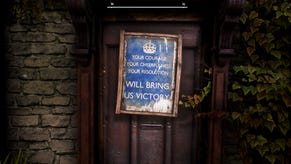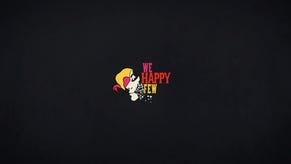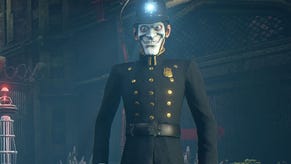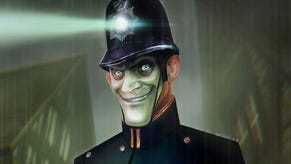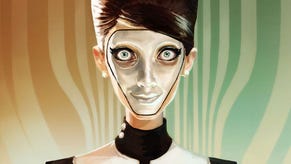We Happy Few Review
Lovely day for it?
This article first appeared on USgamer, a partner publication of VG247. Some content, such as this article, has been migrated to VG247 for posterity after USgamer's closure - but it has not been edited or further vetted by the VG247 team.
We've seen a number of "What if Germany Won World War 2" narratives over the years. The most prominent in the gaming world is MachineGames' Wolfenstein reboot, which posits B.J. Blazkowicz fighting back against the Nazis that won the war, who have subsequently taken over the world. We Happy Few is no exception to this; except there are no Nazis in sight, only hushed murmurs of Germany beyond its British borders. We Happy Few bears a different sort of alternate World War 2-losing scenario.
A lot of it stems from its setting: the small British town of Wellington Wells. Its neighborhoods are connected via bridges, and some are a lot more "civilized" than others. Plus there's a class war looming, and a zombie-like plague infecting people all around. For the rich in the upper-class neighborhoods, they pop "Joy" to stay happy; ignoring the world falling apart around them, ignoring the rotten food they have to eat to stay alive. With Joy, they're happy regardless of circumstance. They're also doped out of their goddamn minds.

We Happy Few famously started as a survival game, with a flashy trailer that led people to believe it'd be an immersive sim, ala BioShock. It wasn't. It still isn't. But the framing is an awful lot like one. From the start, you play as Arthur, a journalist who suddenly remembers his long lost brother (longterm Joy use causes you to forget your memories). He embarks on a quest to find his brother and escape Wellington Wells. Arthur's just one of three characters, and is the center of it all. In Act Two, you play as Sally, an old "friend" of Arthur's who is in a precarious situation and also wants to escape. In Act Three, you take on Ollie, Arthur's old neighbor.
Arthur's a solid all-around character, as he can do chemistry and tinker with things for crafting. As a starter character, it's easy to learn the ropes of We Happy Few's prolific crafting and survival formula with him. The characters you play as after him mix up the action in interesting ways. The explosives expert Ollie has a blood sugar problem, so it's a constant extra balance of keeping his blood sugar in the middle: Not too high or else his health meter steadily drops, and not too low either because he'll become vitriolic and insult passersby, starting lots of fights. Meanwhile Sally has a whole different meter from the others that she has to deal with, and has a higher skill with chemistry too. Sally's the most stealth-ready character, and playing as her forced me to rethink my "f**k it, I'm going Cricket bat blazing" approach to most encounters.
The stealth is where a lot of We Happy Few's persistent problems come to roost. The AI, whether you're dealing with "Bobbies" (guards) or doctors (dudes with red or green hats that can sense if you're off Joy), bug out quite a bit. If you break the evil NPCs out of their pattern, it's hard for them to return to it. For instance, sometimes I'd throw a bottle to distract them, only for more than I intended to run over, huddle around where the bottle broke, and then pace in circles in that specific area or continue on a normal route with a cluster of five or so in one bundle. Another time during a story quest, I had to disguise myself as a municipal worker and speak to a Bobbie to allow me to get onto a bridge that was off limits. After a short cutscene, the few Bobbies and loitering NPCs suddenly turned hostile the moment I was back in control, as if the cutscene never happened. Annoying moments like this happen all too often.
The stealth system, beyond blending into the world, dies by its detection. In other games, you may have a special "detective" button to highlight all enemies in the area, or even a Far Cry-like pinpointing system to spotlight who's around. We Happy Few doesn't have any of these features: Just white footsteps you can see all around you from those close in your vicinity when crouched. There's an upgrade that allows you to see footsteps from farther away, but I found myself wishing there was a more optimal way to see what I needed to watch out for.
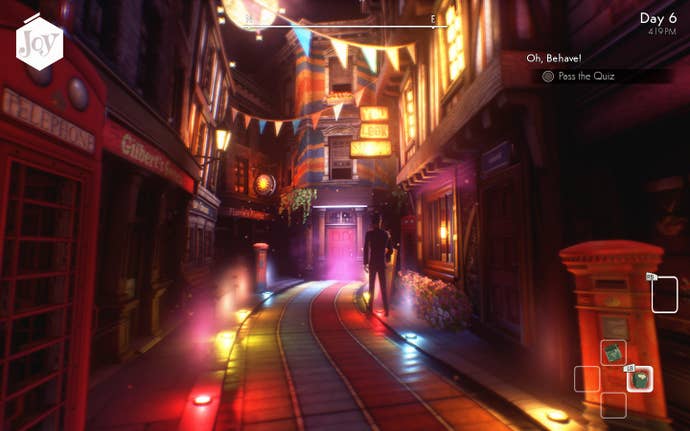

The melee-centered combat also makes for some frustrating situations when more than one NPC is attacking. With Ollie and Sally, I frequently concocted traps and other secondary weapons to help ease the struggle (a box of nails, which makes whatever enemy steps on them bounce on one foot in agony, I found to be essential), but busy combat encounters were still largely a nuisance. And with stealth hints being weak, the NPCs bugging out, and the inconsistent line of sight for getting spotted, group combat was unfortunately very frequent for most of my play time.
The most disappointing thing of all is the potential I see in We Happy Few. Its story confronts the horrors of self-preservation in trying times, and the aftermath of living with (or ignoring) your biggest mistakes. Across the three main characters, the voice acting is excellent too. The world itself is rich in detail and intrigue, and exploring it is consistently a delight. The music is also especially good. Some of my favorite eerie moments involved hearing a song playing in the distance on a seemingly busted record player with the tone sped way down, warping the 1960s rock n' roll into something ominous.
Each character's storyline bears a heavy middle-part that drags plot-wise, or finds itself weighed down by having to do things like loot a bunch of houses to craft one particular thing needed for a quest. At a staggering 30-ish hours (that runtime includes some messing around in side quests), We Happy Few way overstayed its welcome, especially when each character is revisiting the same areas you have already skipped across in the past. Only now, you have to re-unlock hatches for fast travel, making traveling to areas you already know well from previous characters dull all over again.
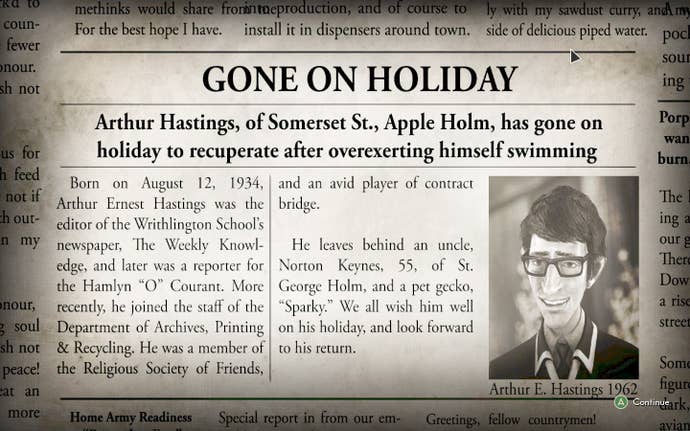
In the future, We Happy Few will be getting a sandbox mode that will allow you to customize its world, food settings, NPCs, and more. Currently its story mode has multiple levels of difficulty, including one where you can customize the difficulty settings, from the survival elements to the combat. It's a nice feature to see, rather than just a blanket harder or easier across everything (though those options are available too; I played on Normal). Still, the incoming sandbox mode seems to lean into what doesn't quite work about We Happy Few—the fact that the survival, weak stealth and combat get in the way of the absorbing world at its center. But maybe with some tuning, players can create a survival sim in its sandbox that's equal parts engaging as it is satisfying. As it is now, We Happy Few is only one of those things. And barely so.
ConclusionThere's a lot to like about We Happy Few, with its unique psychedelic dystopian setting and well-developed story, but it's the moment-to-moment action that crashes down on you like a bad dose of Joy. So-so survival elements, the lack of mission variety, frame rate issues, prolific bugs, and tedious stealth and combat will make you want to cook up some Joy for yourself, so that maybe you too can forget the bad stuff and remember only the bright side of things.



